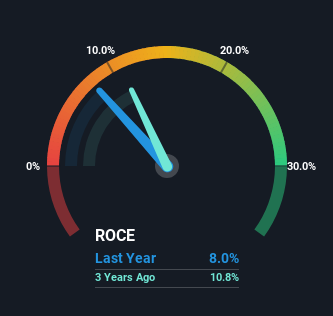- Israel
- /
- Food and Staples Retail
- /
- TASE:YHNF
The Returns On Capital At M.Yochananof and Sons (1988) (TLV:YHNF) Don't Inspire Confidence
Did you know there are some financial metrics that can provide clues of a potential multi-bagger? Firstly, we'd want to identify a growing return on capital employed (ROCE) and then alongside that, an ever-increasing base of capital employed. Put simply, these types of businesses are compounding machines, meaning they are continually reinvesting their earnings at ever-higher rates of return. Although, when we looked at M.Yochananof and Sons (1988) (TLV:YHNF), it didn't seem to tick all of these boxes.
What Is Return On Capital Employed (ROCE)?
For those that aren't sure what ROCE is, it measures the amount of pre-tax profits a company can generate from the capital employed in its business. Analysts use this formula to calculate it for M.Yochananof and Sons (1988):
Return on Capital Employed = Earnings Before Interest and Tax (EBIT) ÷ (Total Assets - Current Liabilities)
0.08 = ₪250m ÷ (₪3.9b - ₪820m) (Based on the trailing twelve months to September 2023).
So, M.Yochananof and Sons (1988) has an ROCE of 8.0%. Even though it's in line with the industry average of 7.7%, it's still a low return by itself.
Check out our latest analysis for M.Yochananof and Sons (1988)

Historical performance is a great place to start when researching a stock so above you can see the gauge for M.Yochananof and Sons (1988)'s ROCE against it's prior returns. If you'd like to look at how M.Yochananof and Sons (1988) has performed in the past in other metrics, you can view this free graph of past earnings, revenue and cash flow.
So How Is M.Yochananof and Sons (1988)'s ROCE Trending?
On the surface, the trend of ROCE at M.Yochananof and Sons (1988) doesn't inspire confidence. Around five years ago the returns on capital were 30%, but since then they've fallen to 8.0%. On the other hand, the company has been employing more capital without a corresponding improvement in sales in the last year, which could suggest these investments are longer term plays. It may take some time before the company starts to see any change in earnings from these investments.
On a side note, M.Yochananof and Sons (1988) has done well to pay down its current liabilities to 21% of total assets. That could partly explain why the ROCE has dropped. Effectively this means their suppliers or short-term creditors are funding less of the business, which reduces some elements of risk. Since the business is basically funding more of its operations with it's own money, you could argue this has made the business less efficient at generating ROCE.
In Conclusion...
Bringing it all together, while we're somewhat encouraged by M.Yochananof and Sons (1988)'s reinvestment in its own business, we're aware that returns are shrinking. Additionally, the stock's total return to shareholders over the last three years has been flat, which isn't too surprising. All in all, the inherent trends aren't typical of multi-baggers, so if that's what you're after, we think you might have more luck elsewhere.
Like most companies, M.Yochananof and Sons (1988) does come with some risks, and we've found 1 warning sign that you should be aware of.
If you want to search for solid companies with great earnings, check out this free list of companies with good balance sheets and impressive returns on equity.
New: Manage All Your Stock Portfolios in One Place
We've created the ultimate portfolio companion for stock investors, and it's free.
• Connect an unlimited number of Portfolios and see your total in one currency
• Be alerted to new Warning Signs or Risks via email or mobile
• Track the Fair Value of your stocks
Have feedback on this article? Concerned about the content? Get in touch with us directly. Alternatively, email editorial-team (at) simplywallst.com.
This article by Simply Wall St is general in nature. We provide commentary based on historical data and analyst forecasts only using an unbiased methodology and our articles are not intended to be financial advice. It does not constitute a recommendation to buy or sell any stock, and does not take account of your objectives, or your financial situation. We aim to bring you long-term focused analysis driven by fundamental data. Note that our analysis may not factor in the latest price-sensitive company announcements or qualitative material. Simply Wall St has no position in any stocks mentioned.
About TASE:YHNF
M.Yochananof and Sons (1988)
Engages in the marketing and retail trade in the food and related products in Israel.
Proven track record with mediocre balance sheet.
Similar Companies
Market Insights
Community Narratives


Recently Updated Narratives


MINISO's fair value is projected at 26.69 with an anticipated PE ratio shift of 20x


The Quiet Giant That Became AI’s Power Grid


Nova Ljubljanska Banka d.d will expect a 11.2% revenue boost driving future growth
Popular Narratives


The company that turned a verb into a global necessity and basically runs the modern internet, digital ads, smartphones, maps, and AI.


MicroVision will explode future revenue by 380.37% with a vision towards success



